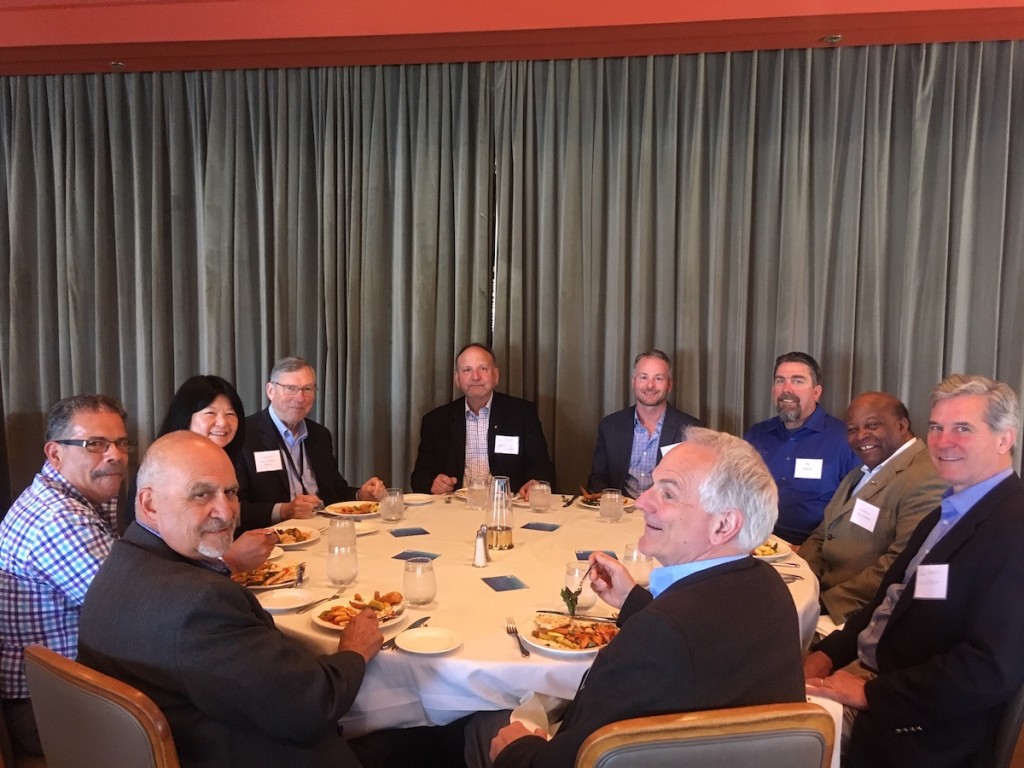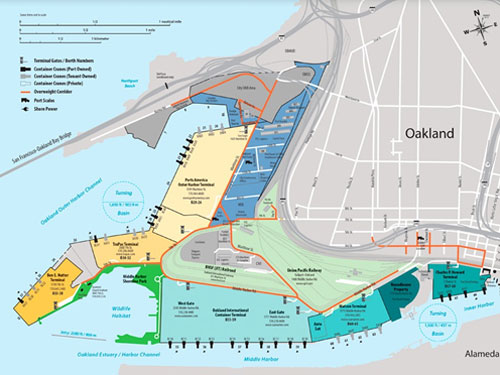Jerry Moro, director of Northern California Operations for the Harbor Trucking Association, says plans for the Oakland Athletics’ baseball park to be constructed at the current site of the Port of Oakland’s Howard Terminal will generate so much car traffic that harbor trucking will be brought to a near standstill during baseball games and other events.
The result will be to place container terminal operations at risk.

The A’s ball park plan has created an unprecedented and unified opposition among Port of Oakland stakeholders that include harbor truckers led by Moro, vessel operators and terminals led by John McLaurin, president of the Pacific Merchant Shipping Association (PMSA) and longshore workers led by Melvin Makay, president of the International Longshore and Warehouse Union (ILWU) Local 10. In another unusual development, McLaurin actually attended the May Day rally hosted by Makay and the ILWU protesting the ball park outside of Howard Terminal. McKay said he was “proud” he and McLaurin were “working together for the common good of the waterfront.”
Last week, the Oakland Board of Port Commissioners approved a term sheet for the proposed baseball stadium project. It gives the A’s four years to complete an environmental impact report and gain public agency approvals. The Board said it would take a final vote on a proposed stadium only after the A’s completed preliminary steps.
The Port sent a letter to customers on May 16th which said the proposed ballpark project provides an opportunity to enhance the Port’s commercial real estate portfolio. Commercial real estate is one of three business lines at the Port of Oakland. The others are the seaport and Oakland International Airport.
The Port’s letter “addressed shipping industry concerns about a ballpark at one of Oakland’s six marine terminals. Questions have arisen over everything from game day traffic to navigational safety on Oakland Estuary where” Howard Terminal is located.
The Port and its governing Board said, “it would work to address potential impacts. They added that a number of issues have already been tackled in the term sheet. Among them:
revisions intended to preserve the Port’s ability to enlarge the Inner Harbor Turning Basin for ships on Oakland Estuary;
a buffer zone area between any proposed residential uses and the adjacent seaport activities; and
a requirement for the submittal of a comprehensive transportation and circulation plan to the Port.”
The result, Moro says, is, is the Oakland A’s are trying to impose a plan that will have the effect of disrupting port operations, posing safety hazards to baseball fans and rail operations and creating new traffic and pollution problems at the Port and for neighbors living in West Oakland.
At the very least, the State of California needs to invest in building a truck only off-ramp for the South-bound 880 freeway to allow trucks to access the Port with a minimum of delay:
“With the infrastructure upgrade if we take the present-day technology, we could create changes to terminal operation that will benefit both the trucking community and the West Oakland area. This will prevent trucks from arriving too early for appointments as they pick up or deliver containers to terminals.“
The Oakland A’s say they support construction of the new truck-only off ramp.
Moro has “serious concerns with the assumptions that the A’s are making to the public about traffic and parking for the ballpark.” He cites the A’s assertion that “50% of fans will drive to the ball park injecting about 6,000 autos into an area that is already highly congested and that everyone else will take public transportation.” He thinks that assumption is incorrect, “When fans realize that it is a mile walk to and from the stadium, they will get in their cars and start to look for parking.”
In a PowerPoint presentation on behalf of the new ball park, the consulting firm of Fehr and Peers argues that there is sufficient parking and public transportation access to the proposed ballpark:
“The ballpark district, located at Howard Terminal within the Port of Oakland, is easily accessible by automobile from the interstate freeway system including Interstate 880 and 980. The district is located about one mile, a 15 to 20-minute walk, from three BART (Bay Area Rapid Transit) stations including West Oakland (15 to 20 minutes), 12thStreet Downtown (15 to 20 minutes), and Lake Merritt (20 to 25 minutes). There is an Amtrak/Capital Corridor train station about one-half mile from the ballpark district, transit bus service is within one-quarter mile of the district and the Jack London Ferry Terminal is a short walk to the district. Today, there are about 16,000 on- and off-street parking spaces within a 30-minute walk of the ballpark district.”
The firm projects the following ‘Attendee Travel Mode’ and compares it with the “Existing Coliseum” travel patterns at the Oakland Coliseum where the A’s currently play baseball:


The A’s say they will speed access to the ball park from distant parking lots using an overhead gondola, similar to what is used at ski areas, that can carry 6,000 fans per hour.
Moro is concerned about this projection: “The A’s say the gondola system will carry 6,000 people per hour from parking areas a mile away to the ball park, even if that’s correct, which I question, that means that the gondola system” may still not be able to reduce the need for people to walk long distances to get to the ball park from parking areas and require that they cross existing rail road tracks which could pose a safety hazard.
Fehr & Peers notes: “The Ballpark District is located between the water and the railroad corridor so that most people and commerce must cross the railroad tracks to access the district. Roughly 40 trains per day between 11 AM and 11 PM (when activities are likely to occur at the ballpark) pass through the area.”
Moro says that the Embarcadero Street rail line which runs in front of the proposed ball park will pose a threat to pedestrians: “There is the safety concern. Embarcadero has the railroad running down the middle of the street. There are 37 trains a day that move on this length of track.” Moro notes that the A’s project that the gondola “will go over the tracks and they would build bridge ways for pedestrians” He remains concerned that “some people may still walk across the tracks when trains are running.”
Fehr & Peers does express concern about the traffic congestion problem:
“Last, we get to the automobiles. There are two ways in and out of the site – Market Street and Martin Luther King Jr Way. These have limited capacity because of the small intersection blocks through Jack London District (roughly 200 x 300 feet) and the railroad tracks. We are finding that both corridors are heavily congestion between Howard Terminal and 7thStreet which is north of the I-880 structure. This is critical as we start to look for ways to flush people after a game (sic).That is one reason for the Phase 1 development including a concentration of commercial activities around the ballpark. This time-shifts when people arrive and leave a game or other event at the ballpark.”
Moro says this point raises a concern about additional days of traffic and congestion impacting port operations. While the A’s have projected 80 home games per year, which does not seem excessive factoring 365 days per year, Moro says “what you’ve got to understand is that we’re talking not just 80 ball games a year at the new stadium but also added events and who knows how many there will be.”
The Port of Oakland stakeholders, who oppose the ball park, say the A’s plan to use the ball park as the first step towards expanding development further westward. This encroaches on existing Port of Oakland maritime operations. The result, they say, will be more commercial as well as high-end housing development that the A’s are planning for westwards along the Oakland Estuary.
Already, one critical truck parking area to the west of the proposed ball park is slated to be taken over for ball park parking. Moro says this critical truck parking area, known as the ‘Roundhouse’, has been cited by the A’s as an area they want to use for fan parking: “For us that’s a big deal, it’s a loss of truck parking. It also puts automobiles and pedestrians in the terminal operation area if this area is ever made part of the stadium complex.”

Moro says that truckers will also be forced to park and idle their trucks in the adjacent West Oakland neighborhood.
In April, the Port of Oakland announced a new plan to minimize trucking in West Oakland. The plan was developed jointly by the City of Oakland and the Port. It targets thousands of harbor trucks hauling containers at the Port as well as trucks that will serve new buildings on city property under development at a former Oakland Army Base near the Port. The plan would guide where trucks access the Port. The plan would propose strict limits on parking trucks in commercial and industrial areas that are close to residential neighborhoods. The Port is budgeting $2.35 million over five years for its role in implementing the plan.
Moro says that as a result of the ballpark plan, this commitment to the West Oakland community is probably no longer viable: “There is simply nowhere to park the trucks except in West Oakland.”
Finally, he notes: “There is also a downstream impact that will affect business along the extended overweight corridor and the Free Trade Zone. These businesses rely on a path that eventually takes them down 3rd Street to the terminal area. With the increase in pedestrian and automobile traffic this route will no longer exist.”

